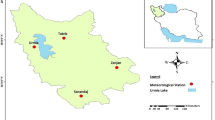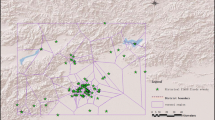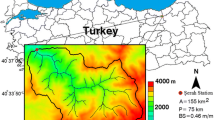Abstract
Here we use a Discriminant Genetic Algorithm Extended (DGAE) model to diagnose and predict seasonal sand and dust storm (SDS) activities occurring in Northeast Asia. The study employed the regular meteorological data, including surface data, upper air data, and NCEP reanalysis data, collected from 1980–2006. The regional, seasonal, and annual differences of 3-D atmospheric circulation structures and SDS activities in the context of spatial and temporal distributions were given. Genetic algorithms were introduced with the further extension of promoting SDS seasonal predication from multi-level resolution. Genetic probability was used as a substitute for posterior probability of multi-level discriminants, to show the dual characteristics of crossover inheritance and mutation and to build a non-linear adaptability function in line with extended genetic algorithms. This has unveiled the spatial distribution of the maximum adaptability, allowing the forecast field to be defined by the population with the largest probability, and made discriminant genetic extension possible. In addition, the effort has led to the establishment of a regional model for predicting seasonal SDS activities in East Asia. The model was tested to predict the spring SDS activities occurring in North China from 2007 to 2009. The experimental forecast resulted in highly discriminant intensity ratings and regional distributions of SDS activities, which are a meaningful reference for seasonal SDS predictions in the future.
Similar content being viewed by others
References
Zhang Q, Gao G, Wang M, et al. Monitoring and early warning services for spatial and temporal changes of droughts and floods In China in recent 50 years (in Chinese). 200 Years Annual Meeting of Chinese Meteorological Society. Beijing: China Meteorological Press, 2004. 383–384
Li C Y. Introduction to Dynamic Climate (in Chinese). Beijing: China Meteorological Press, 1995. 1–4
Ding J, Zhu T. Heterogeneous reactions on the surface of fine particles in the atmosphere. Chin Sci Bull, 2003, 48: 2267–2276
Shi G Y, Zhao S X. On the scientific problems of sandstorm study (in Chinese). Chin J Atmos Sci, 2003, 27: 591–606
Shen S H, Chen S J. Numerical simulation for frontogenesis process due to radiation forcing of sand storms (in Chinese). Acta Meteorol Sin, 2003, 27: 591–606
Wang S G, Yang D B, Jin T, et al. Black storm in Northwest China causes and countermeasures (in Chinese). J Desert Res, 1995, 15: 19–30
Zhang X Y. Spring Sandstorms in Northeast Asia in 2006 (in Chinese). Beijing: China Meteorological Press, 2006. 9–19
Thompson D W J, Wallace J M. The Arctic Oscillation signature in the wintertime geo-potential height and temperature fields. Geophys Res Lett, 1998, 25: 1297–1300
He C, He J H. The relationship between the northern polar oscillation and temperature variations in winter (in Chinese). J Nanjing Instit Meteorol, 2003, 26: 1–7
Swap R. Dust in the Amazon Basin. Tellus, 1992, 44B: 133–149
Franzen L G. The Saharan dust episode of southern and central Europe, and northern Scandinavia March, 1991. Weather, 1995, 50: 313–318
Genthon C. Simulations of desert dust and sea-salt aerosols in Antarctica with a general circulation model of the atmosphere. Tellus Ser B-Chem Phys Meteoral, 1992, 44: 371–389
Joseph P V, Raipal D K, Deka S N, et al. The convective dust storms of Northwest India. Mausam, 1980, 31: 431–442
Wolfson N, Marson M. Satellite 1986: Observations of a phantom the desert. Weather, 1986, 41: 57–60
Iwasaka Y. The transport and spatial scale of Asian dust-storm clouds: A case study of the dust-storm event of April, 1979. Tellus Ser B-Chem Phys Meteoral, 1983, 35: 189–196
Ellis J R, W G, Merrill J T. Trajectories for Saharan dust transported to Barbados using Stokes’s law to describe gravitational settling. J Applied Meteorol, 1995, 34: 1716–1726
Cuevas E, Baldasano J M, Pérez C, et al. The SDS-GEOEurope GEO-System oriented System. International Sand and Dust Storm Warning System. Barcelona: WMO/GEO Expert Meeting, 2007. 7–9
Gao Q X, Su F Q, Ren Z H, et al. Sandstorms in Beijing and its impact (in Chinese). China Envirnment, 2002, 32: 468–471
Zhang S L, Gong S L, Shen Z X, et al. Characterization of soil dust aerosol in China and its transport and distribution during 2003 ACE-Asia. J Geophys Res, 2003, 108(D9): 4261, doi: 10.1029/2002JD002632
Ye D Z, Chou J F, Liu J Y. A study on the causes of sandstorms in northern China and its countermeasures (in Chinese). Acta Geograph Sin, 2000, 55: 513–521
Kang D J, Wang H J. Analysis on the decadal scale variation of the dust storm in North China. Sci China Ser D-Earth Sci, 2005, 48: 2260–2266
Yang Y Q, Hou Q, Zhou C H, et al. Sand/dust storm processes in Northeast Asia and associated large-scale circulations. Atmos Chem Phys, 2008, 8: 25–33
Wang Y Q, Zhang X Y. The contribution from distant dust spruces to the atmospheric particulate matter loading at Xi’an, China during spring. Sci Total Environment, 2006, 368: 875–883
Wang J Z, Yang Y Q, Zhou C H, et al. A study on weather process characteristics of spring SDS in 1980–2007. In: Fifth International Workshop on Sand and Dust Storms (SDS). Beijing: Meteorology Press, 2008. 9–11
Sun J, Li Z C. A Preliminary study on Sandstorms forecast method in the northwest of Chin (in Chinese). Meteorol Monthly, 2001, 27: 19–24
Fan K, Wang H J. Interannual variability of Antarctic Oscillation and its influence on East Asian climate during boreal winter and spring. Sci China Ser D-Earth Sci, 2006, 49: 554–560
Gong S L, Barrie L A, Blanchet J P, et al. Canadian aerosol module: A size-segregated simulation of atmospheric aerosol processes for climate and air quality models 1. Module development. J Geophys Res, 108(D1): 4007, doi: 10.1029/20012003JD002002
Folland C K, Colman A. A multivariate technique for use in long-range forecasting. Programme Long-range Forecasting WMO/TD, 1985, 87: 628–636
Song L C, Yu Y X, Sun X Y, et al. Relationship between Arctic Oscillation and strong sandstorm in the North of China (in Chinese). Plateau Meteorol, 2004, 23: 835–839
Li Y, Wang J Z, Chen L S, et al. Study on rainfall distribution associated with typhoon Matsa (2005). Chin Sci Bull, 2007, 52: 972–983
Gao S T, Tao S Y, Ding Y H. Interaction between upper air waves and East Asia jet during cold wave (in Chinese). Chin J Atmos Sci, 1992, 16: 718–724
Cochran W G, Bliss C I. Discriminant function with covariance. Ann Math Statist, 1948, 19: 151–176
Miller R G. Statistical prediction by discriminant analysis. Meteorol Monmg, 1962, 4: 1–15
Suzuki E. Categorical prediction schemes of rainfall types by discriminant analysis. Papers Meteorol Geophys, 1964, 15: 119–160
Wang J Z, Yang Y Q. Modern Weather Engineering (in Chinese). Beijing: China Meteorological Press, 2000. 334–339
Keenan T D. Forecasting tropical cyclone motion using a discriminant analysis procedure. Mon Rev, 1986, 144: 434–441
Yang Y Q, Hou Q, Wang J Z. A study on prediction of SDS annual, tendency and operational testing. In: Fifth International Workshop on Sand and Dust Storms (SDS). Beijing: Meteorology Press, 2008. 21–24
Yang Y Q, Wang J Z. An integrated decision method for prediction of tropical cyclone movement by using genetic algorithm. Sci China Ser D-Earth Sci, 2005, 48: 429–440
Li Q L, Xu X F. A self-adaptive genetic algorithm for partner selection of agile virtual enterprise (in Chinese). Infor Adv Techn, 2001, 10: 66–69
Author information
Authors and Affiliations
Corresponding author
Rights and permissions
About this article
Cite this article
Yang, Y., Wang, J., Hou, Q. et al. Discriminant Genetic Algorithm Extended (DGAE) model for seasonal sand and dust storm prediction. Sci. China Earth Sci. 54, 10–18 (2011). https://doi.org/10.1007/s11430-010-4059-z
Received:
Accepted:
Published:
Issue Date:
DOI: https://doi.org/10.1007/s11430-010-4059-z




